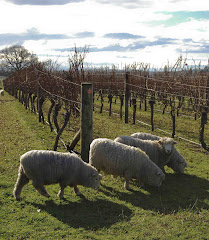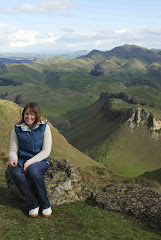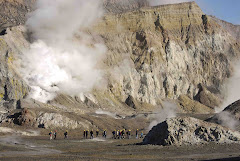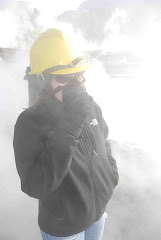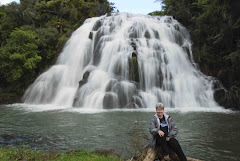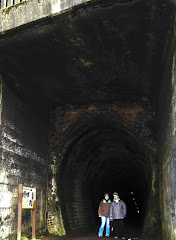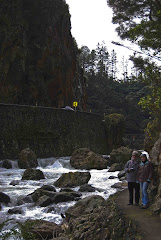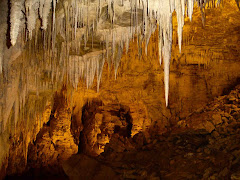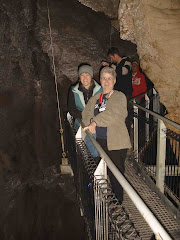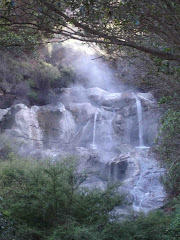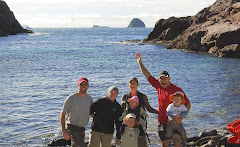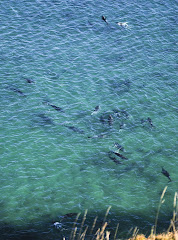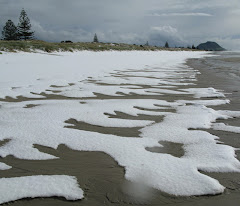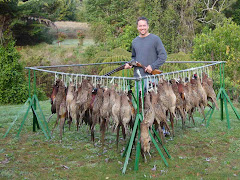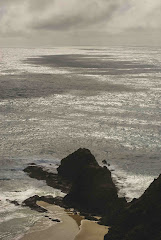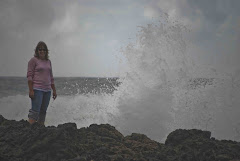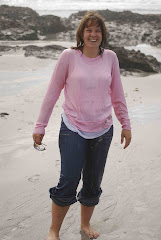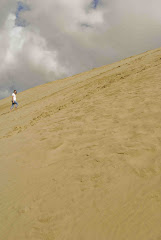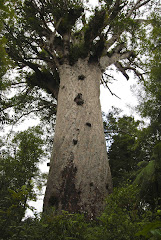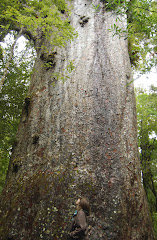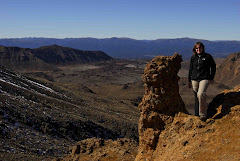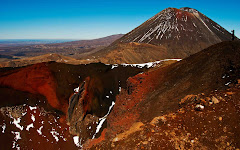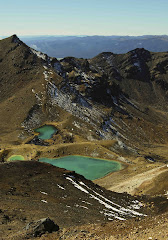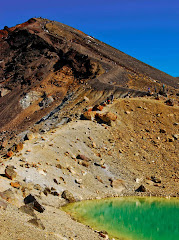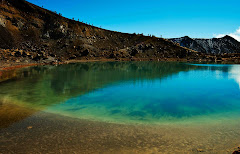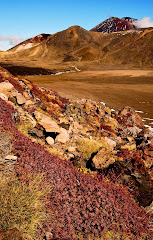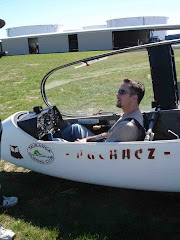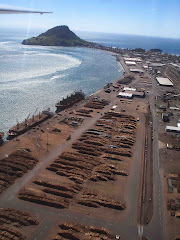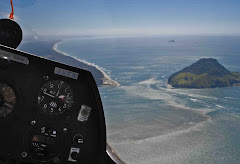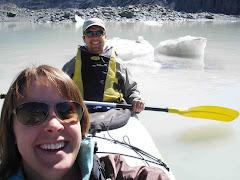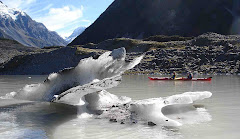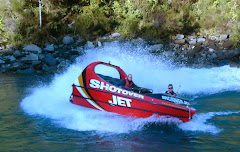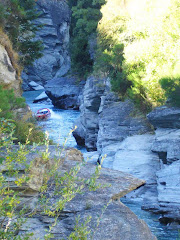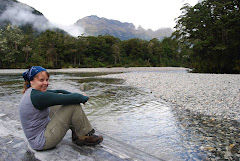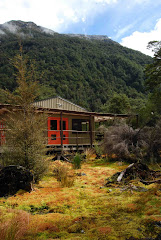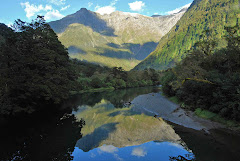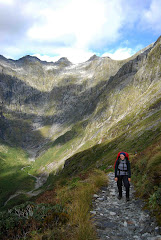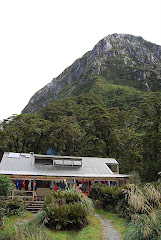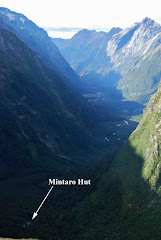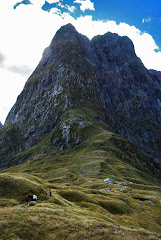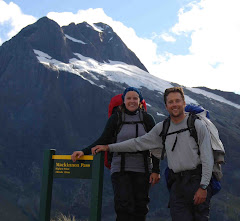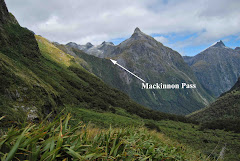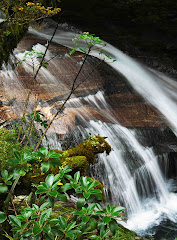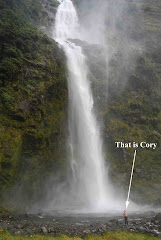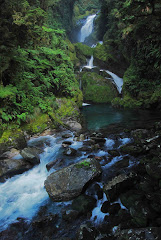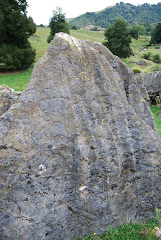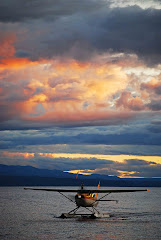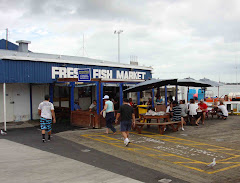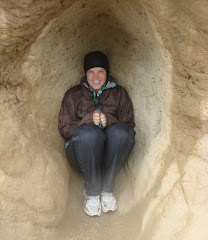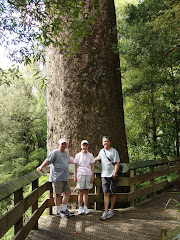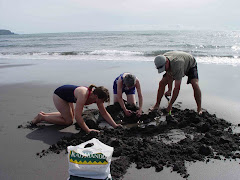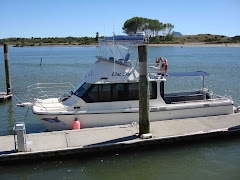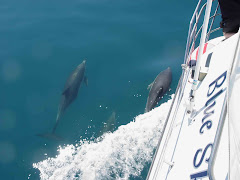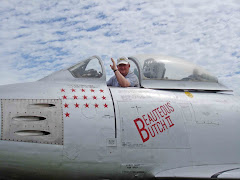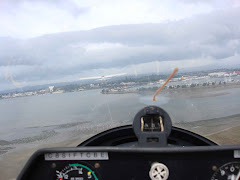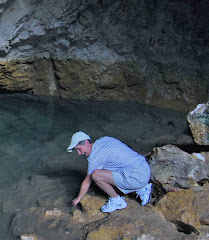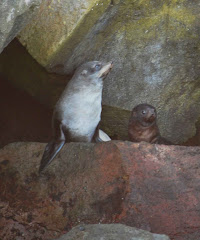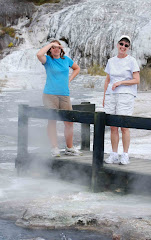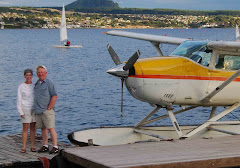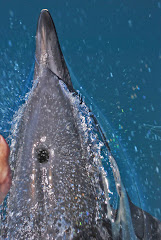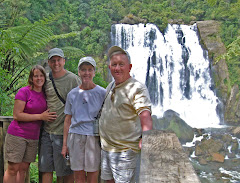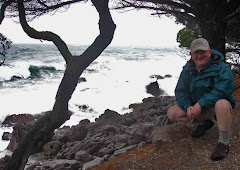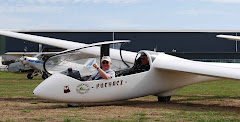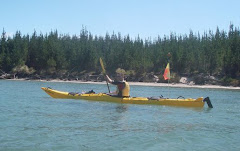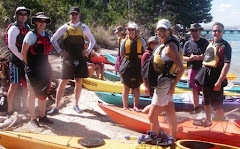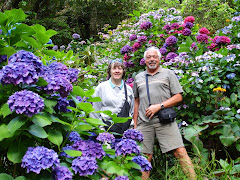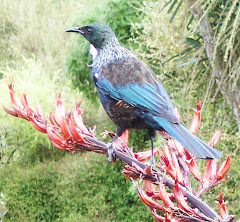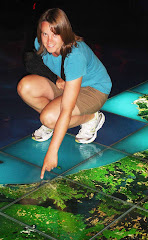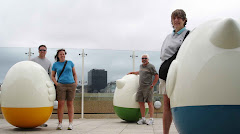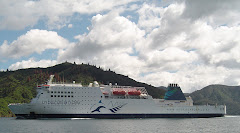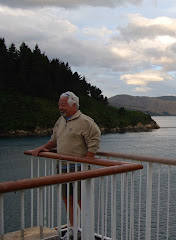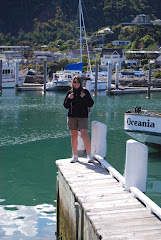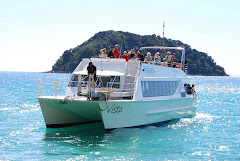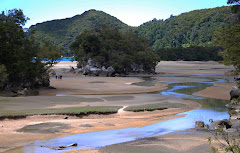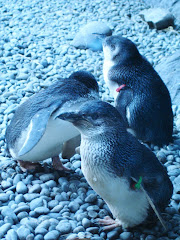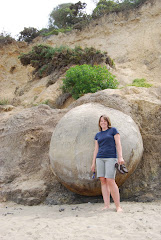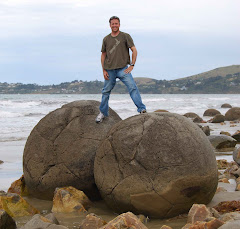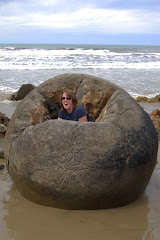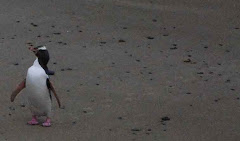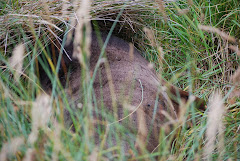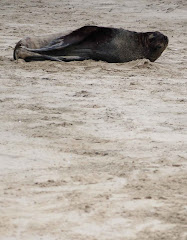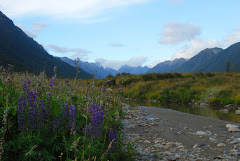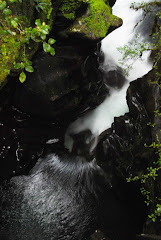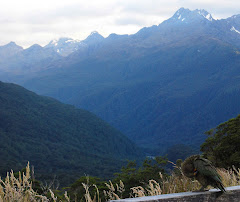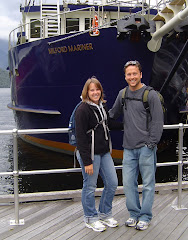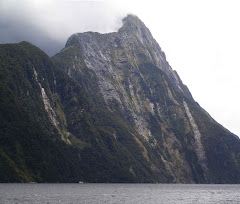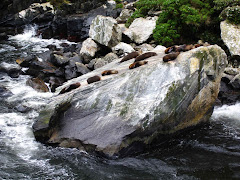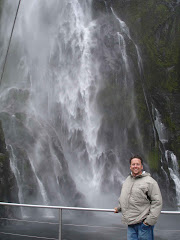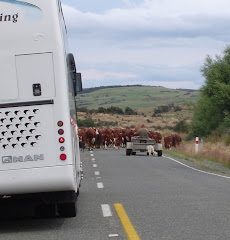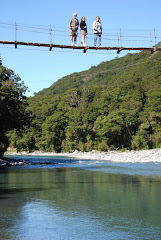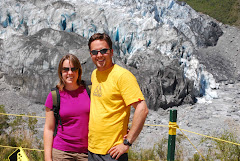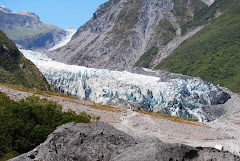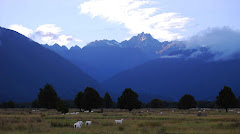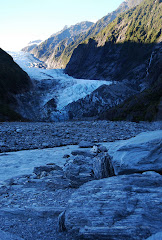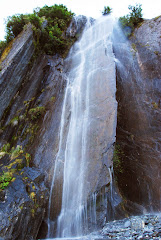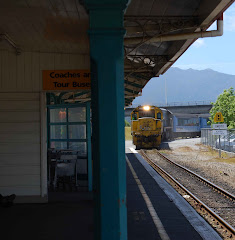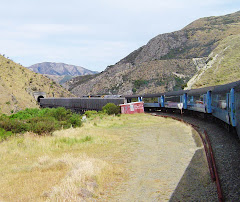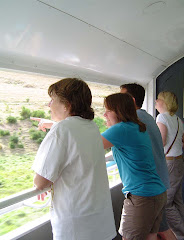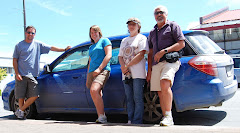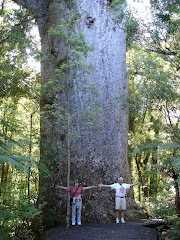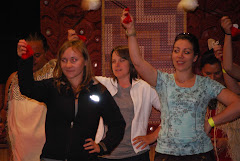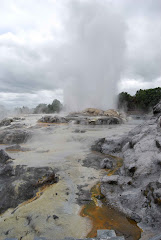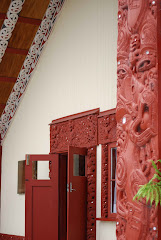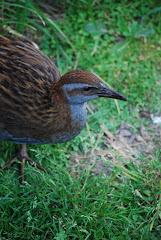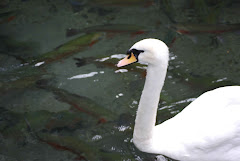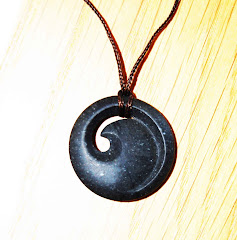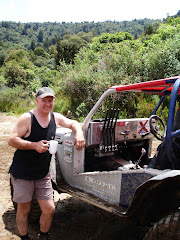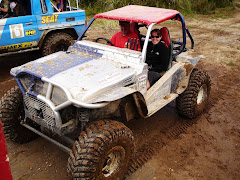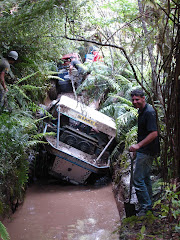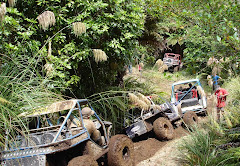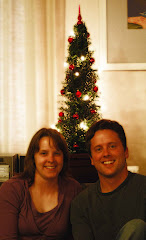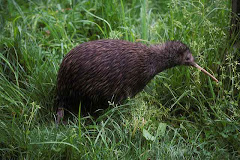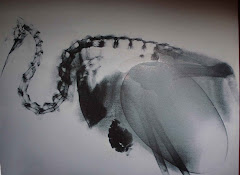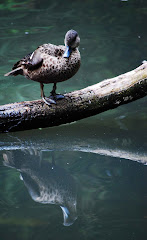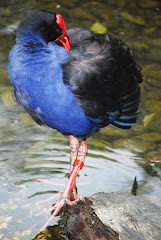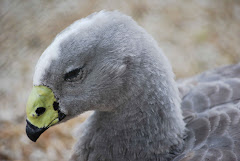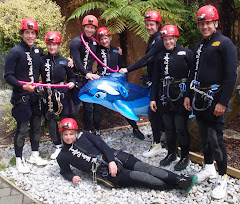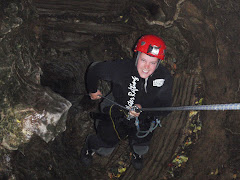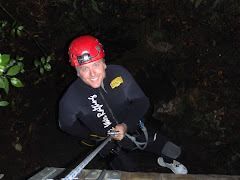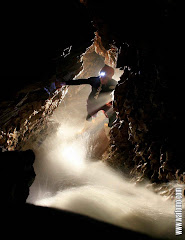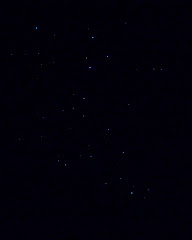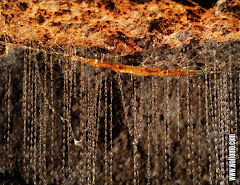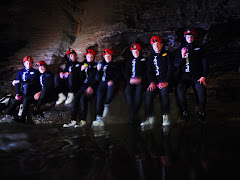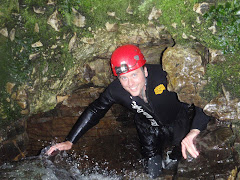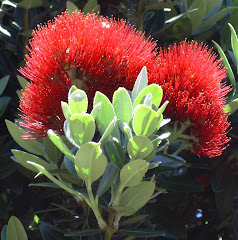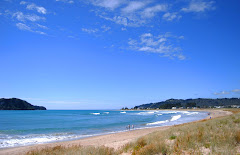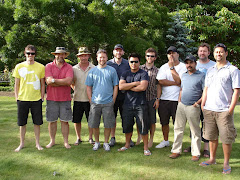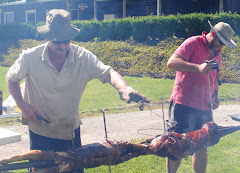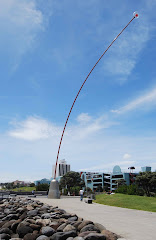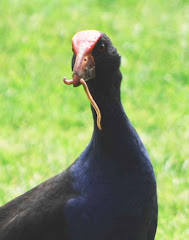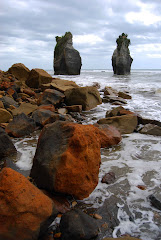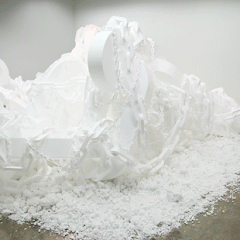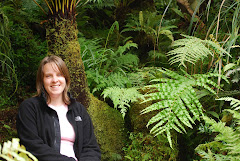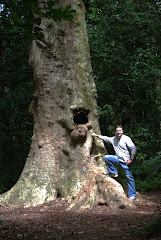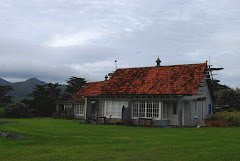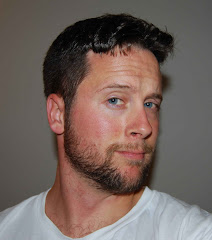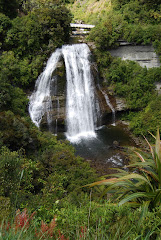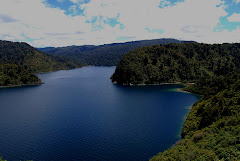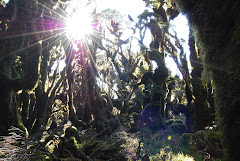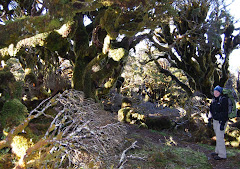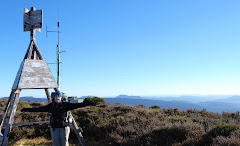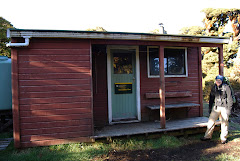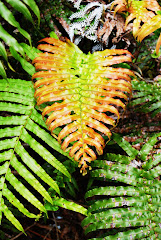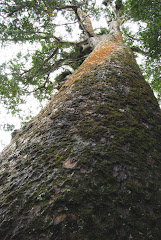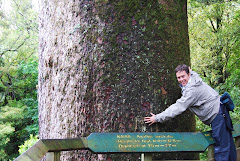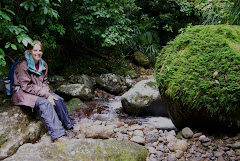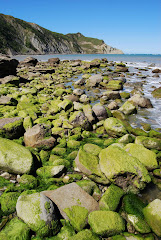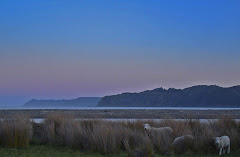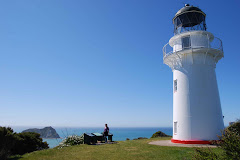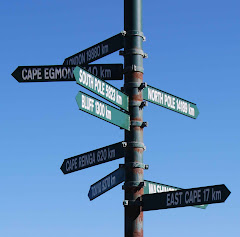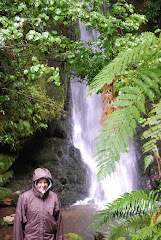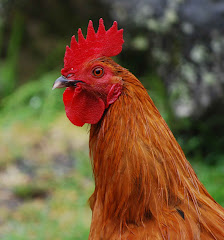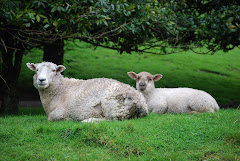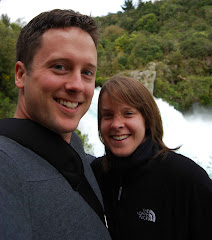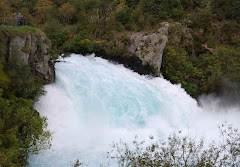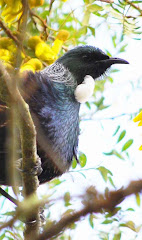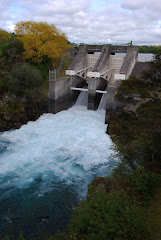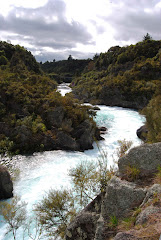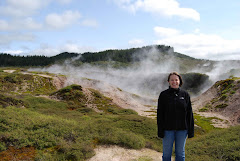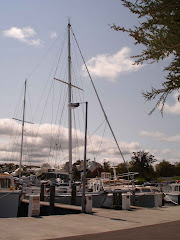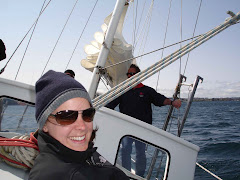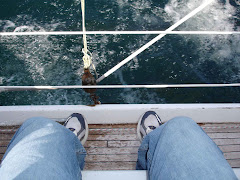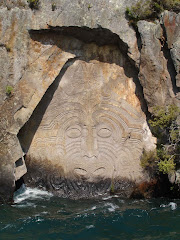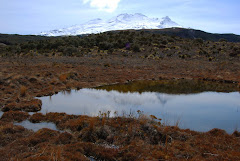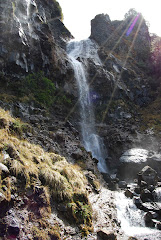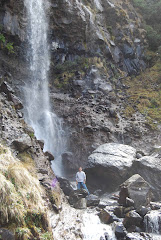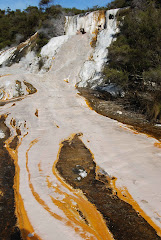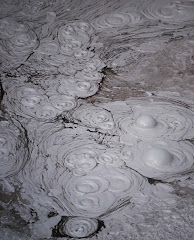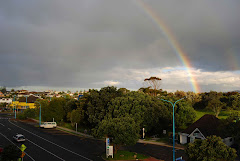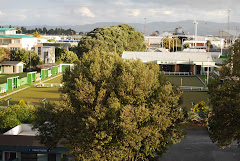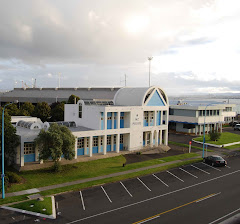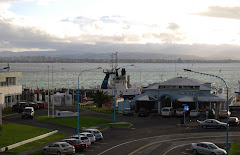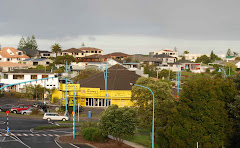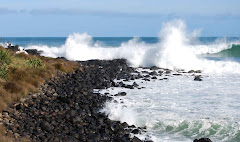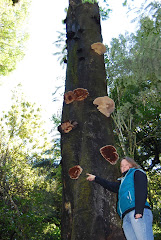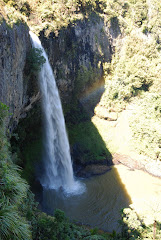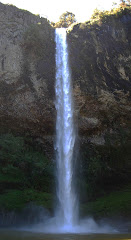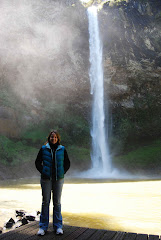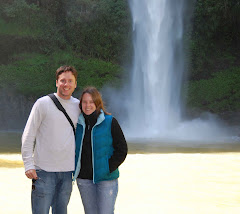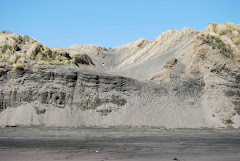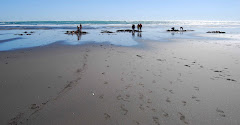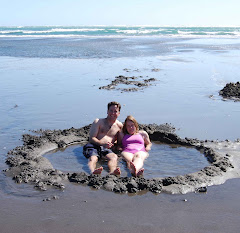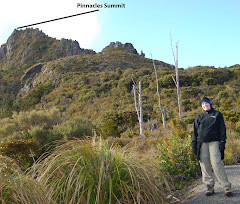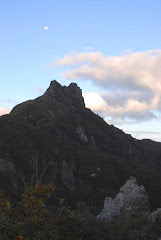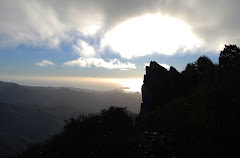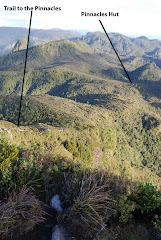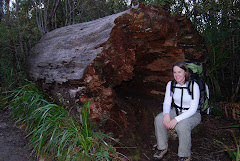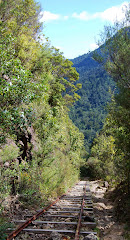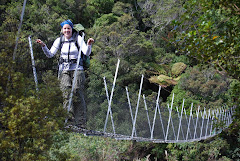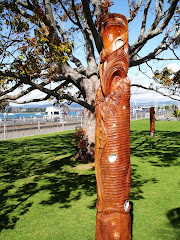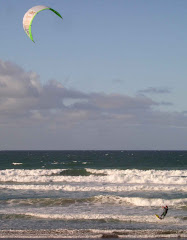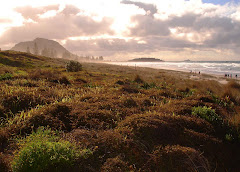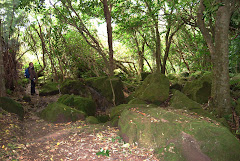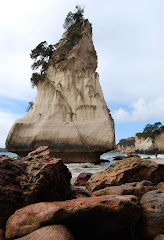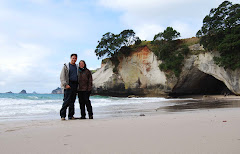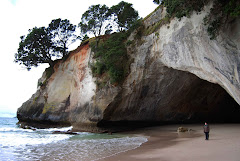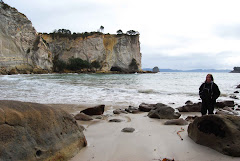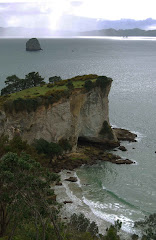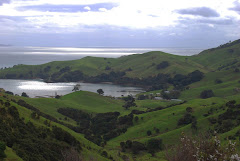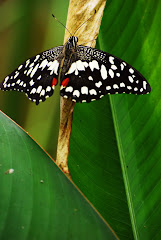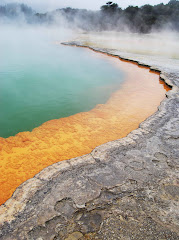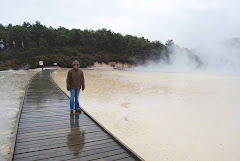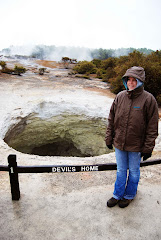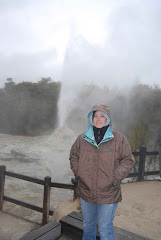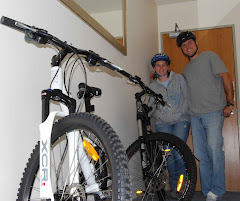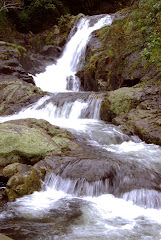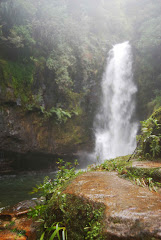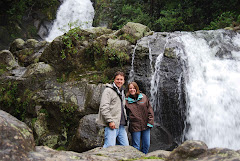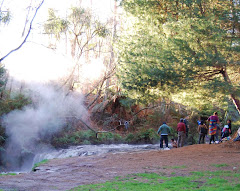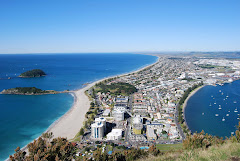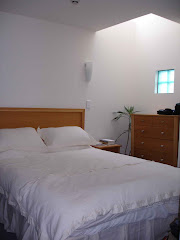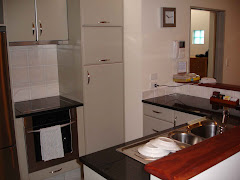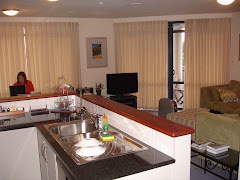We celebrated our four-year wedding anniversary a little early and spent last weekend in New Plymouth. New Plymouth is on the west coast and is about a four-hour drive from the Mount. We hopped in the car early on Saturday morning and headed out.
Our first stop once in New Plymouth was for lunch at the café in Puke Ariki, the regional museum. Breakfast and lunch are not left to the restaurateurs, with small cafés often being found in shops, parks, and museums. Cory had pizza, which he swears is the best he’s had since leaving Iowa. He desperately misses Wig ‘n Pen, Pagliai’s, Salvatore’s, Old Chicago – anywhere that can make a pepperoni pizza to his liking. He has suggested we might have to drive back just so he can order pizza again, so that alone probably would have made the weekend worth it!
After a quick tour of the museum, we headed to Pukekura, a fantastic park in the city. There are several different kinds of gardens, plus a cricket oval and an amphitheatre. It also boasts a 2000-year-old puriri tree and a flock of pukekos. Pukekos are also known as swamp hens and are very common all over New Zealand. And while some might find them annoying, I think they are fascinating to watch! Maybe sort of like squirrels…
We stayed that night at the Ahu Ahu Beach Villas, right on the coast. The villas are gorgeous and, interestingly, made from reclaimed materials from the area. The view from the windows was pretty great too. That night and the next morning, we walked along the black sand beach. Cory can’t really walk along a beach without collecting, and we came back with some driftwood, a great paua shell, a snail shell, and a few other bits of detritus that he eventually decided wouldn’t get to make the trip home. At some point we are going to have to creatively display the shell collection we are amassing, as it is starting to take over the flat surfaces in the house…
Speaking of taking over, we headed to the Govett-Brewster Art Gallery Sunday morning and viewed an installment by Peter Robinson. The multiple floors of the small gallery had been filled with huge linked chains carved from Styrofoam. While it sounds completely bizarre, it really was awesome to see. We caught the last day of the show, and the staff were discussing how exactly the work would be “un-installed.” A company was going to take all of the Styrofoam and recycle/re-use it, but there wasn’t a set plan as to how it was all going to get taken down – though someone did mention a chainsaw!
The gallery is also known for its Len Lye collection. In addition to film projects, Lye did a lot with kinetic sculptures. We saw some crazy video of a few of his works, and then got to see his “Wind Wand” up close and in person down at the waterfront. Wacky, but fascinating.
We headed out of town, hoping to catch a glimpse of Mount Taranaki. The entire weekend it was clouded in misty fog; we never saw the peak. We did a short hike in the Egmont National Park (Egmont being Taranaki’s other name) and if you had not known there was a mountain in the area, there is no way you would have guessed it.
On our drive home, we made a short side-trip to see the Three Sisters. Sadly, since naming, one has crumbled into the sea, so only two of them remain. Again, I would be at a loss for how to describe them, so make use of your imagination and Cory’s small photo on the sidebar. These are the spots that really blow me away. Again and again, we have stumbled onto areas that are really fascinatingly beautiful and often indescribable but that don’t make it into guidebooks or the local town’s tourist information. Word of mouth and a small sign are often all that points you in the direction. I think, though, these areas are often the highlight of our travels. And maybe that inconspicuousness adds to the draw.
Friday, November 28, 2008
Tuesday, November 25, 2008
Happy Thanksgiving!
I’m sure it dawned on all of you that Thanksgiving is an American holiday. But we couldn’t miss out on the opportunity for a big meal, so we decided to have some friends over to share our American Thanksgiving meal.
The first challenge came in setting a day/time when our guests could all make it over to our place. Cory has three co-workers that he has worked closely with that he really likes. All three are also leaving for new placements at the end of November. The guys and their wives have been very kind and accommodating in our first few months here, so sharing a meal with them really was to be a “thank you” of sorts (assuming, of course, that the meal turned out well and I didn’t give anyone food poisoning). After many phone calls and a few schedule changes, it was settled.
Both Cory and I love throwing parties, but they tend to be very casual (“food is in the kitchen and drink are on the deck – help yourself”). I’d not hosted a sit-down meal for eight before. The second challenge came in figuring out how to seat eight when you really are only set-up for six. Luckily our outdoor table and chairs scrubbed up acceptably, and the Warehouse has inexpensive plates and silverware. The local op-shop (Salvation Army) had serving pieces for a reasonable amount as well. Whew!
I really wanted to do a traditional meal. Maybe this is par for the course, but both my family and Cory’s family tend to have the same/similar menu from year-to-year and I really wanted to make some of those customary dishes. Now, I’ve made most of those dishes before, but not all at the same time, so I knew that alone would be another challenge. Plus, daringly, I told Cory I would make his mom’s famous dinner rolls. This is Cory’s favorite part of any holiday meal cooked by Karen, and, while I wanted to make them for him, I knew I was also setting myself up for the potential for a great failure! Oh, the pressure…
I also needed to find a turkey. For whatever reason, turkey in any form is not very common around New Zealand. We’ve seen several live turkeys in the hillsides when driving, but there is no turkey lunch meat at the deli and I’d not seen whole turkeys in the freezer section at any of the grocery stores. I’d heard about a website where you could order them to be delivered to you, but they didn’t start delivering until December 1st – and we’d all ready invited everyone for November 16th! Uh, oops. But I got lucky – unbelievably, the grocery store had 3 turkeys in their freezer section! I was also able to find cranberries there, too.
The menu had been set – turkey, dressing, mashed potatoes, green bean casserole, creamed corn casserole, baked squash with apples, gravy, rolls, cranberry-orange relish, pumpkin bars, strawberries, and chocolates. I had to get Mom and Dad to email me several recipes and had to call on Karen for others. (This included the famous roll recipe which began with “At 4:30, dissolve the yeast…” and was then further broken down into half-hour to hourly segments. What had I gotten myself into!?)
When in doubt, plan meticulously. This has sort of been my mantra as a teacher and it carried over well to my cooking. I mapped out what I could make in advance and started several days before the big meal, making pumpkin bars and several casseroles a few days in advance. I saved the rolls for the night before, and saved the turkey, mashed potatoes, gravy (I cheated and used a packet – I hate gravy), and cranberry-orange relish for the big day.
Remarkably, this meant the day of the meal was mostly stress-free. My biggest concern was locating the neck of the turkey which was inexplicably missing from the carcass of the bird. This didn’t really concern me, as I had no intention of using it for anything, but I did sort of think I should find it before someone else did. Cory’s surgeon skills were put to use carving, which was a great help. And miraculously, all the dishes were the appropriate temperature and the appropriate time. (I just knew one of my casseroles was going to be cold in the middle when everything else was ready.)
The much-anticipated rolls even turned out okay. I think they were a little tougher in consistency than Karen’s usually are, but I had to mix the last half of the flour in by hand which may have stressed the dough a little (my poor mixer couldn’t handle the job). Cory was kind and said they were just right.
The tables looked nice enough, all set for dinner. I forgot to offer anyone anything to drink and failed to pour water for people, but they seemed to fend for themselves just fine. Jason kept asking if we were doing things according to tradition, and I reassured him that the only tradition that was important once the eating commenced was that you go back for seconds. It seems most of the guys did, so I guess that was a good sign.
Cory and I have just about made it through what leftovers there were. He was happy to have some extra turkey and I have been mixing cranberry-orange relish in with my yogurt (and may be for many days to come)! Everyone was very complimentary of the meal, but you never know if that is just good manners or actual enjoyment. In either case, I'll take it.
This Thursday, Thanksgiving proper, will be spent, coincidentally, dining with friends again. When you are away from home for such a holiday, the most you can ask for is good people to share it with…
The first challenge came in setting a day/time when our guests could all make it over to our place. Cory has three co-workers that he has worked closely with that he really likes. All three are also leaving for new placements at the end of November. The guys and their wives have been very kind and accommodating in our first few months here, so sharing a meal with them really was to be a “thank you” of sorts (assuming, of course, that the meal turned out well and I didn’t give anyone food poisoning). After many phone calls and a few schedule changes, it was settled.
Both Cory and I love throwing parties, but they tend to be very casual (“food is in the kitchen and drink are on the deck – help yourself”). I’d not hosted a sit-down meal for eight before. The second challenge came in figuring out how to seat eight when you really are only set-up for six. Luckily our outdoor table and chairs scrubbed up acceptably, and the Warehouse has inexpensive plates and silverware. The local op-shop (Salvation Army) had serving pieces for a reasonable amount as well. Whew!
I really wanted to do a traditional meal. Maybe this is par for the course, but both my family and Cory’s family tend to have the same/similar menu from year-to-year and I really wanted to make some of those customary dishes. Now, I’ve made most of those dishes before, but not all at the same time, so I knew that alone would be another challenge. Plus, daringly, I told Cory I would make his mom’s famous dinner rolls. This is Cory’s favorite part of any holiday meal cooked by Karen, and, while I wanted to make them for him, I knew I was also setting myself up for the potential for a great failure! Oh, the pressure…
I also needed to find a turkey. For whatever reason, turkey in any form is not very common around New Zealand. We’ve seen several live turkeys in the hillsides when driving, but there is no turkey lunch meat at the deli and I’d not seen whole turkeys in the freezer section at any of the grocery stores. I’d heard about a website where you could order them to be delivered to you, but they didn’t start delivering until December 1st – and we’d all ready invited everyone for November 16th! Uh, oops. But I got lucky – unbelievably, the grocery store had 3 turkeys in their freezer section! I was also able to find cranberries there, too.
The menu had been set – turkey, dressing, mashed potatoes, green bean casserole, creamed corn casserole, baked squash with apples, gravy, rolls, cranberry-orange relish, pumpkin bars, strawberries, and chocolates. I had to get Mom and Dad to email me several recipes and had to call on Karen for others. (This included the famous roll recipe which began with “At 4:30, dissolve the yeast…” and was then further broken down into half-hour to hourly segments. What had I gotten myself into!?)
When in doubt, plan meticulously. This has sort of been my mantra as a teacher and it carried over well to my cooking. I mapped out what I could make in advance and started several days before the big meal, making pumpkin bars and several casseroles a few days in advance. I saved the rolls for the night before, and saved the turkey, mashed potatoes, gravy (I cheated and used a packet – I hate gravy), and cranberry-orange relish for the big day.
Remarkably, this meant the day of the meal was mostly stress-free. My biggest concern was locating the neck of the turkey which was inexplicably missing from the carcass of the bird. This didn’t really concern me, as I had no intention of using it for anything, but I did sort of think I should find it before someone else did. Cory’s surgeon skills were put to use carving, which was a great help. And miraculously, all the dishes were the appropriate temperature and the appropriate time. (I just knew one of my casseroles was going to be cold in the middle when everything else was ready.)
The much-anticipated rolls even turned out okay. I think they were a little tougher in consistency than Karen’s usually are, but I had to mix the last half of the flour in by hand which may have stressed the dough a little (my poor mixer couldn’t handle the job). Cory was kind and said they were just right.
The tables looked nice enough, all set for dinner. I forgot to offer anyone anything to drink and failed to pour water for people, but they seemed to fend for themselves just fine. Jason kept asking if we were doing things according to tradition, and I reassured him that the only tradition that was important once the eating commenced was that you go back for seconds. It seems most of the guys did, so I guess that was a good sign.
Cory and I have just about made it through what leftovers there were. He was happy to have some extra turkey and I have been mixing cranberry-orange relish in with my yogurt (and may be for many days to come)! Everyone was very complimentary of the meal, but you never know if that is just good manners or actual enjoyment. In either case, I'll take it.
This Thursday, Thanksgiving proper, will be spent, coincidentally, dining with friends again. When you are away from home for such a holiday, the most you can ask for is good people to share it with…
Happy Movember!
Perhaps I should comment on my photo, “Happy Movember.” No, this is not a typo; we are truly celebrating Movember here in New Zealand. Movember is derived from mo, which is short for moustache, and November, the month to recognize men’s health issues, such as prostate cancer awareness. To show their support, men all over New Zealand sport a mo or some other unattractive form of facial hair. The Orthopaedic Department at Tauranga Hospital has adopted this tradition, and this year have modified the theme to be “Into the Wild” and therefore have opted for beards (at least those of us who can grow one, sorry Jason). A month of ridicule for my scraggly beard is worth it to support such a worthy cause. At the end of the month (which can’t come soon enough according to Erin) we will be judged, photographed, and eventually shaved. The photographs are put together in a calendar and sold. Proceeds are then donated to supporting charities. So next November, embrace your manliness, pitch the razor, and support Movember with your very own mo.
Thursday, November 13, 2008
Te Urewera
It was definitely time for a hike, so Cory and I planned our next tramp for this past weekend. The best-known walks seem to be multiple-day walks, maybe 3-4 days long. But Cory purchased a book with 1-2 day hikes, which are much more do-able for us, as we can do them in a weekend and Cory doesn’t have to take time off.
The hikes in the book are rated easy, medium, and hard. There aren’t too many hard ones, as these tend to require mountaineering and/or climbing skills. We’d done some hikes rated as “easy” and found that they were not exactly what I would describe as a walk in the park, but that they weren’t too bad. The one we chose for last weekend was rated “medium” but the book explained that this was due to the length of the walk. The plan was to head to Te Urewera National Park. We would hike about 5-6 hours in to a hut, spend the night, and then hike back out on Sunday.
The hut system here is really nice; there isn’t really anything like it in Iowa. Along set trails, there are huts for people to stay the night. You simply need to purchase an inexpensive pass at the local Department of Conservation to stay there. There are different “levels” of huts, which indicate sort of which amenities they offer; this is usually based on how popular the walk. Huts range from the “standard” variety – with pit toilets, water, and bunks to “Great Walk” huts, which usually have several bunk rooms (sleeping up to 30 or so), a cooking area with heating sources and maybe a grill, water, and toilets.
Our planned walk was to Manuoha Hut, which fell in to the “standard” category. Really, that should have been our first warning. If this was a fun, pleasant walk, it would be well-traversed and would require a somewhat larger hut.
Our second and third warnings were more obvious, but we disregarded them all the same. As we were chatting with the officer at the Department of Conservation in Te Urewera (after driving on almost-two-lane, mostly-gravel roads for an hour-and-a-half), he mentioned that it was supposed to snow up on the summit. Two key words here… “snow” and “summit”. I was so freaked out by the word “snow” that I almost disregarded the word “summit”. Manuoha is the highest peak in the small range within Te Urewera. Granted, it is small – only 1400 meters, but normally, I would not agree to I walk up anything that has had the word “summit” applied to it. But – really – SNOW!? Are you kidding me? I thought perhaps the officer was, but he wasn’t the smiling type, and it seemed that the forecast from the Met did involve snow. As Cory pointed out, it was probably not really snow, just flurries. Small comfort, but I was persuaded on all the same.
Another warning was posted at the trail head. The sign read “Mt. Manuoha Hut – 7 hours”. While these times are usually a little off, this was an hour longer than what we’d planned. Yikes. But they are off sometimes… so on we went.
The last warning came shortly after we started our walk. Within about 20 feet of the trailhead , I was clambering up a rocky, steep slope, using my hands to grasp rocks and tree roots to help me up, while lugging my pack and losing my breath. At this point there was still time to turn around, but did we give in to the warning signs? Of course not. (Though I totally would have if Cory had made any noises in that direction.)
I tried to tell myself that the trail would get better, but the landscape was telling a different tale. For an hour and a half, we clambered upward, using trees, roots, and rocks as handholds. Often I had to swing my knees, one at a time, over a particularly steep ledge, into a crawling position before I could get up on my feet. Remember, as you are trying to stop laughing at that visual, that I am carrying a large backpack with food, a stove, a pot/pan set, and a sleeping bag in it. And I’m muttering to myself. Sometimes cursing, sometimes encouraging, but always muttering. Now, go ahead and laugh…
After the first hour and half, the climb slackened somewhat – but we still had four hours to go! I didn’t know that at the time, because I didn’t see the little hand-carved sign tacked to a tree. And Cory didn’t point it out - good thinking on his part…
As we continued the climb/walk, we did pass through some amazing scenery. From a barren spot along the ridge, you could see the summit. I was so grateful to know it was visible. And once we got to the summit, we knew the hut was close. I was so, so, so pleased!
Of course, we still had the night to go, you know, with “flurries” possible! We dropped our packs and Cory set about getting a fire going, as I worked on getting dinner ready. The wood, though, was so damp, even after working for probably an hour, Cory couldn’t get a fire started. So we ate a dinner of partially cooked rice (I need some more practice with the stove) and tomato soup and headed to bed. We crawled into our sleeping bags fully dressed, including our hats and gloves. Luckily, Stacy and Clay got us some great sleeping bags and we were warm all night long. When we woke up, the sun was shining, and it was warmer than it had been when we made it to the hut. What a relief!We did still have the walk down, but I was in much better spirits, knowing that downhill would be easier. And it was, except for that last hour and half. Going down what we had previously come up was just as tricky! It was good to know, sort of, that I wasn’t just being a wimp, but that it had been quite a tough climb. And I’ve never been as glad to see our car. We took off down the almost-two-lane, mostly-gravel road.
Oh, but the adventures weren’t quite over. After about an hour and a half, those gravel roads ended and we stopped at Murupara, which is the closest town to Te Urewera. We were really hungry and popped into a fish and chips store to order lunch. After we placed our order, we waited out on the sidewalk, watching what appeared to be most of the town drive by. A campervan pulled up next to our car and a long, loud hissing sound began. I commented to Cory how glad I was we had decided against the campervan for our South Island trip – I mean, who wants a vehicle that makes that sort of suspicious noise?
Well, after we picked up our fish and chips, we realized that the suspicious noise had actually been coming from our car! Our drivers-side front wheel was resting on its rim, the tire completely flat. Luckily Cory has had plenty of practice with changing tires and, in all his sensibleness, had insisted on purchasing a full-sized spare. So I got the jack out, while he began loosening lug nuts. But, with the car jacked up and the lug nuts off, we discovered that we couldn’t get the wheel off the car. (I use the term “we” here, but I was really just a not-so-useful observer.) By this time, we’d attracted some attention, and several people had dropped by to offer advice. The most helpful girl agreed that, indeed, the wheel did not want to seem to come off, and hollered to a young guy driving by for a hammer. The hammer was promptly supplied and the owner applied it to the backside of the wheel – and off it popped. Cory quickly put the spare on, popped on the classy wheel cover, and we were ready to go. Another woman said we should check in at the garage and see if they could fix it for us. So we said goodbye to our new friends and headed to the garage. They had the tire fixed in about as much time as it took to pump gas, and they charged us a whopping $8.00. Unbelieveable. If you have to break down in New Zealand, I would pick Murupara.
That classy wheel-cover, by the way, made it through most, but not all, of the ride home. As we were taking off from a red light on the far side of Tauranga, Cory heard the sound of plastic meeting asphalt. We thought about stopping, turning around, and running through traffic to pick it up, but decided against it. I think the old Honda can do without.
(A short note... When we got home, we referred back to the book of recommended tramps. Seems we'd failed to note the sentence that discussed a "steep climb" at the start of the Manuoha Hut Track. Whoops.)
The hikes in the book are rated easy, medium, and hard. There aren’t too many hard ones, as these tend to require mountaineering and/or climbing skills. We’d done some hikes rated as “easy” and found that they were not exactly what I would describe as a walk in the park, but that they weren’t too bad. The one we chose for last weekend was rated “medium” but the book explained that this was due to the length of the walk. The plan was to head to Te Urewera National Park. We would hike about 5-6 hours in to a hut, spend the night, and then hike back out on Sunday.
The hut system here is really nice; there isn’t really anything like it in Iowa. Along set trails, there are huts for people to stay the night. You simply need to purchase an inexpensive pass at the local Department of Conservation to stay there. There are different “levels” of huts, which indicate sort of which amenities they offer; this is usually based on how popular the walk. Huts range from the “standard” variety – with pit toilets, water, and bunks to “Great Walk” huts, which usually have several bunk rooms (sleeping up to 30 or so), a cooking area with heating sources and maybe a grill, water, and toilets.
Our planned walk was to Manuoha Hut, which fell in to the “standard” category. Really, that should have been our first warning. If this was a fun, pleasant walk, it would be well-traversed and would require a somewhat larger hut.
Our second and third warnings were more obvious, but we disregarded them all the same. As we were chatting with the officer at the Department of Conservation in Te Urewera (after driving on almost-two-lane, mostly-gravel roads for an hour-and-a-half), he mentioned that it was supposed to snow up on the summit. Two key words here… “snow” and “summit”. I was so freaked out by the word “snow” that I almost disregarded the word “summit”. Manuoha is the highest peak in the small range within Te Urewera. Granted, it is small – only 1400 meters, but normally, I would not agree to I walk up anything that has had the word “summit” applied to it. But – really – SNOW!? Are you kidding me? I thought perhaps the officer was, but he wasn’t the smiling type, and it seemed that the forecast from the Met did involve snow. As Cory pointed out, it was probably not really snow, just flurries. Small comfort, but I was persuaded on all the same.
Another warning was posted at the trail head. The sign read “Mt. Manuoha Hut – 7 hours”. While these times are usually a little off, this was an hour longer than what we’d planned. Yikes. But they are off sometimes… so on we went.
The last warning came shortly after we started our walk. Within about 20 feet of the trailhead , I was clambering up a rocky, steep slope, using my hands to grasp rocks and tree roots to help me up, while lugging my pack and losing my breath. At this point there was still time to turn around, but did we give in to the warning signs? Of course not. (Though I totally would have if Cory had made any noises in that direction.)
I tried to tell myself that the trail would get better, but the landscape was telling a different tale. For an hour and a half, we clambered upward, using trees, roots, and rocks as handholds. Often I had to swing my knees, one at a time, over a particularly steep ledge, into a crawling position before I could get up on my feet. Remember, as you are trying to stop laughing at that visual, that I am carrying a large backpack with food, a stove, a pot/pan set, and a sleeping bag in it. And I’m muttering to myself. Sometimes cursing, sometimes encouraging, but always muttering. Now, go ahead and laugh…
After the first hour and half, the climb slackened somewhat – but we still had four hours to go! I didn’t know that at the time, because I didn’t see the little hand-carved sign tacked to a tree. And Cory didn’t point it out - good thinking on his part…
As we continued the climb/walk, we did pass through some amazing scenery. From a barren spot along the ridge, you could see the summit. I was so grateful to know it was visible. And once we got to the summit, we knew the hut was close. I was so, so, so pleased!
Of course, we still had the night to go, you know, with “flurries” possible! We dropped our packs and Cory set about getting a fire going, as I worked on getting dinner ready. The wood, though, was so damp, even after working for probably an hour, Cory couldn’t get a fire started. So we ate a dinner of partially cooked rice (I need some more practice with the stove) and tomato soup and headed to bed. We crawled into our sleeping bags fully dressed, including our hats and gloves. Luckily, Stacy and Clay got us some great sleeping bags and we were warm all night long. When we woke up, the sun was shining, and it was warmer than it had been when we made it to the hut. What a relief!We did still have the walk down, but I was in much better spirits, knowing that downhill would be easier. And it was, except for that last hour and half. Going down what we had previously come up was just as tricky! It was good to know, sort of, that I wasn’t just being a wimp, but that it had been quite a tough climb. And I’ve never been as glad to see our car. We took off down the almost-two-lane, mostly-gravel road.
Oh, but the adventures weren’t quite over. After about an hour and a half, those gravel roads ended and we stopped at Murupara, which is the closest town to Te Urewera. We were really hungry and popped into a fish and chips store to order lunch. After we placed our order, we waited out on the sidewalk, watching what appeared to be most of the town drive by. A campervan pulled up next to our car and a long, loud hissing sound began. I commented to Cory how glad I was we had decided against the campervan for our South Island trip – I mean, who wants a vehicle that makes that sort of suspicious noise?
Well, after we picked up our fish and chips, we realized that the suspicious noise had actually been coming from our car! Our drivers-side front wheel was resting on its rim, the tire completely flat. Luckily Cory has had plenty of practice with changing tires and, in all his sensibleness, had insisted on purchasing a full-sized spare. So I got the jack out, while he began loosening lug nuts. But, with the car jacked up and the lug nuts off, we discovered that we couldn’t get the wheel off the car. (I use the term “we” here, but I was really just a not-so-useful observer.) By this time, we’d attracted some attention, and several people had dropped by to offer advice. The most helpful girl agreed that, indeed, the wheel did not want to seem to come off, and hollered to a young guy driving by for a hammer. The hammer was promptly supplied and the owner applied it to the backside of the wheel – and off it popped. Cory quickly put the spare on, popped on the classy wheel cover, and we were ready to go. Another woman said we should check in at the garage and see if they could fix it for us. So we said goodbye to our new friends and headed to the garage. They had the tire fixed in about as much time as it took to pump gas, and they charged us a whopping $8.00. Unbelieveable. If you have to break down in New Zealand, I would pick Murupara.
That classy wheel-cover, by the way, made it through most, but not all, of the ride home. As we were taking off from a red light on the far side of Tauranga, Cory heard the sound of plastic meeting asphalt. We thought about stopping, turning around, and running through traffic to pick it up, but decided against it. I think the old Honda can do without.
(A short note... When we got home, we referred back to the book of recommended tramps. Seems we'd failed to note the sentence that discussed a "steep climb" at the start of the Manuoha Hut Track. Whoops.)
Thursday, November 6, 2008
Kia Ora!
I talked Cory into signing up for a Maori language and culture class with me at Otumoetai College, the regular education high school where I’m volunteering. The colleges here offer a broad range of vocational skills training, making their campuses a great place for a variety of continuing ed classes, from financial planning to gluten-free cooking to beginning guitar.
We meet on Wednesday evenings for about two hours; so far we’ve had three classes and are loving it! Our instructor, Ihaka, is the instructor for Te Reo Maori (“the Maori language”) at the college and he is really good. I was pretty worried on the first night – I didn’t know how far behind the other students we would be. I thought that everyone else would have pretty good pronunciation skills and would be working on their conversational skills. Luckily for us, it has turned out that we are in pretty much the same boat as the other 7 students.
At first I was really surprised by our classmates’ general lack of knowledge of Maori. The students in both the special education placements I volunteer at use some of the language – both in song and in basic nouns and commands. I assumed then that adults who were not disabled would have a much better grasp of the language. But as I’ve been doing a little more reading/thinking, I’m guessing that there was a time period that Maori had no role in the traditional school. It seems that there is always that battle of assimilation – how much a group has to give up to fit in. I think, in some ways, that rocky period might be over, and there has been resurgence in the use of Te Reo in public settings – radio stations, a tv station, and speech-making competitions for youth.
I imagine that Maori people were at one time discouraged from practicing their language and culture. As Europeans settled in New Zealand in increasing numbers, Maori people remained in rural areas. Families and their extended kin, the hapu (sub-tribe), remained strong because Maori people lived near each other, using their language and practicing traditional customs. Slowly though, like the industrial revolution in the US, the bulk of the Maori population has shifted to larger urban areas for work opportunities. This movement seems to have weakened the hapu and thus decreased the use of Maori language and customs.
New Zealand is still a relatively young country, and New Zealanders, both of European, Maori, and other descent, are really still sorting things out. As the election in the US progressed, both Cory and I fielded a lot of questions about racism in America. (I’ll save that and a report on some of the other impressions of American that are held here.) But while it is an uncomfortable subject, one that neither of us have ventured to bring up with any Kiwis here, there is some lingering racism here in New Zealand.
The Treaty of Waitangi officially created the republic of New Zealand. It was a document signed by leaders of European settlers and leaders of (some) Maori tribes. The document was written in English and then translated into Maori. The translation was difficult, and both groups came away with different understandings of what had been agreed to. As a result, there are still ongoing disputes over areas of land. The Waitangi Tribunal was set up to resolve these disputes, but the claims are many and the progress is slow. Land that had been usurped by settlers has, at times, been returned to the iwi (tribe) that once ruled it. As you can imagine, this has not always gone over well with the non-Maori of the area.
But, as problem-fraught as the situation is, you have to hand it to the Kiwis. They are working hard to maintain the identity and offer fair treatment to the various cultures that call New Zealand home.
And, now, back to the point… There seems to, then, have once been a period when Maori language was not commonly spoken, which has lead to our classmates’ lack of knowledge and current desire to learn. The positive for us is that the class has moved slowly, focusing so far on pronunciation and greetings. There is an important and fairly extensive greeting, which identifies to listeners the places that are important to you (mihi) and outlines your family genealogy (whakapapa). On our last night of class, we will be offering our introduction to the elders of a local iwi. It is something I am actually very nervous about, as it feels as if it is a presentation of oneself, and I’d like to do it well. I’ll leave you with a transcript of my mihi; I’ll save my whakapapa for another day!
Ko Honda te waka/ My canoe is Honda
(You should put the name of the boat that brought you to the land; the Maori people arrived in New Zealand in sea-going canoes and can name the waka that brought their descendents.)
Ko Pilots Knob te maunga/My mountain is Pilots’ Knob
(Really, what mountain does a girl from Iowa identify with?)
Ko Mississippi te awa/ My river is Mississippi
(At least this one was easy.)
Ko te kainga te marae/My meeting place is my home
(This is one that doesn’t have a good fit, but iwis and hapus have a meeting place that is very important and steeped in history. Some classmates have listed their church in this place as well.)
Ko Amerikan te iwi/My tribe is American
(It sounds weird, but it’s accurate.)
Ko Payne te hapu/My sub-tribe is the Payne family
Ko Erin toku ingoa/My name is Erin
We meet on Wednesday evenings for about two hours; so far we’ve had three classes and are loving it! Our instructor, Ihaka, is the instructor for Te Reo Maori (“the Maori language”) at the college and he is really good. I was pretty worried on the first night – I didn’t know how far behind the other students we would be. I thought that everyone else would have pretty good pronunciation skills and would be working on their conversational skills. Luckily for us, it has turned out that we are in pretty much the same boat as the other 7 students.
At first I was really surprised by our classmates’ general lack of knowledge of Maori. The students in both the special education placements I volunteer at use some of the language – both in song and in basic nouns and commands. I assumed then that adults who were not disabled would have a much better grasp of the language. But as I’ve been doing a little more reading/thinking, I’m guessing that there was a time period that Maori had no role in the traditional school. It seems that there is always that battle of assimilation – how much a group has to give up to fit in. I think, in some ways, that rocky period might be over, and there has been resurgence in the use of Te Reo in public settings – radio stations, a tv station, and speech-making competitions for youth.
I imagine that Maori people were at one time discouraged from practicing their language and culture. As Europeans settled in New Zealand in increasing numbers, Maori people remained in rural areas. Families and their extended kin, the hapu (sub-tribe), remained strong because Maori people lived near each other, using their language and practicing traditional customs. Slowly though, like the industrial revolution in the US, the bulk of the Maori population has shifted to larger urban areas for work opportunities. This movement seems to have weakened the hapu and thus decreased the use of Maori language and customs.
New Zealand is still a relatively young country, and New Zealanders, both of European, Maori, and other descent, are really still sorting things out. As the election in the US progressed, both Cory and I fielded a lot of questions about racism in America. (I’ll save that and a report on some of the other impressions of American that are held here.) But while it is an uncomfortable subject, one that neither of us have ventured to bring up with any Kiwis here, there is some lingering racism here in New Zealand.
The Treaty of Waitangi officially created the republic of New Zealand. It was a document signed by leaders of European settlers and leaders of (some) Maori tribes. The document was written in English and then translated into Maori. The translation was difficult, and both groups came away with different understandings of what had been agreed to. As a result, there are still ongoing disputes over areas of land. The Waitangi Tribunal was set up to resolve these disputes, but the claims are many and the progress is slow. Land that had been usurped by settlers has, at times, been returned to the iwi (tribe) that once ruled it. As you can imagine, this has not always gone over well with the non-Maori of the area.
But, as problem-fraught as the situation is, you have to hand it to the Kiwis. They are working hard to maintain the identity and offer fair treatment to the various cultures that call New Zealand home.
And, now, back to the point… There seems to, then, have once been a period when Maori language was not commonly spoken, which has lead to our classmates’ lack of knowledge and current desire to learn. The positive for us is that the class has moved slowly, focusing so far on pronunciation and greetings. There is an important and fairly extensive greeting, which identifies to listeners the places that are important to you (mihi) and outlines your family genealogy (whakapapa). On our last night of class, we will be offering our introduction to the elders of a local iwi. It is something I am actually very nervous about, as it feels as if it is a presentation of oneself, and I’d like to do it well. I’ll leave you with a transcript of my mihi; I’ll save my whakapapa for another day!
Ko Honda te waka/ My canoe is Honda
(You should put the name of the boat that brought you to the land; the Maori people arrived in New Zealand in sea-going canoes and can name the waka that brought their descendents.)
Ko Pilots Knob te maunga/My mountain is Pilots’ Knob
(Really, what mountain does a girl from Iowa identify with?)
Ko Mississippi te awa/ My river is Mississippi
(At least this one was easy.)
Ko te kainga te marae/My meeting place is my home
(This is one that doesn’t have a good fit, but iwis and hapus have a meeting place that is very important and steeped in history. Some classmates have listed their church in this place as well.)
Ko Amerikan te iwi/My tribe is American
(It sounds weird, but it’s accurate.)
Ko Payne te hapu/My sub-tribe is the Payne family
Ko Erin toku ingoa/My name is Erin
Tuesday, November 4, 2008
The election and other fun events
As the US is gearing up for it’s big election day, so is New Zealand. Both elections have been covered closely in the media here. George Bush is pretty much despised by Kiwis, so regardless of who is finally elected, there is elation at the thought of change. I would say, though, that there is general excitement on this side of the world at the possibility of a black president for the US. I’m sure the principal at Kaka Street will be able to give me hourly updates tomorrow (our Wednesday) as the election results begin to come in – we’ll both be eagerly awaiting the news.
Here in NZ, campaigning is also in full-swing, with their big vote on the 8th. In 1996, the governmental set-up changed to multi-party representation (specifically “mixed-member proportional representation”). I’m going to butcher this (and poli-sci majors, forgive me), but here goes… Essentially a Kiwi voter has two votes. One goes to the individual who they would like for their local MP or Member of Parliament; the other goes for a party. The percentage of votes a party receives indicates the percentage of the Parliament that will be made up by that party. Following me? There are lots of parties – National and Labour are the largest two – but don’t forget about the Maori, Green, ACT, NZ First, Kiwi, and others as well. Now, to get something passed, these groups need to form coalitions and band together to have the necessary supporting votes. So you have to be aware of what other parties your preferred party aligns itself with. All-in-all, very interesting… If you have not followed my amazing dissertation on MMP here, feel free to check out http://www.elections.org.nz/voting/mmp/ for a better overview!
In addition to the election fun, we’ve had and will have two holidays. Last Friday was Halloween, which is not the spectacle here as it is in the US. There were some costume events for the 20s crowd, and while the commercial entities would like trick-or-treating to catch on (if only to sell costumes and candy), it just hasn’t done so yet. Tomorrow we’ll celebrate Guy Fawkes Day. I’ve been spending a lot of time getting people to explain Guy Fawkes Day; in turn, I’ve been doing a fair bit of explaining about Thanksgiving. Guy Fawkes is pretty much a day to light some firecrackers, it seems. Today, though, a student did quote to me the specific day that Guy Fawkes was caught, attempting his act of treason (November 5, 1975) – which I found pretty impressive for a special ed student. There is another fun November event coming up, but I’ll leave that for Cory to explain another day…
Here in NZ, campaigning is also in full-swing, with their big vote on the 8th. In 1996, the governmental set-up changed to multi-party representation (specifically “mixed-member proportional representation”). I’m going to butcher this (and poli-sci majors, forgive me), but here goes… Essentially a Kiwi voter has two votes. One goes to the individual who they would like for their local MP or Member of Parliament; the other goes for a party. The percentage of votes a party receives indicates the percentage of the Parliament that will be made up by that party. Following me? There are lots of parties – National and Labour are the largest two – but don’t forget about the Maori, Green, ACT, NZ First, Kiwi, and others as well. Now, to get something passed, these groups need to form coalitions and band together to have the necessary supporting votes. So you have to be aware of what other parties your preferred party aligns itself with. All-in-all, very interesting… If you have not followed my amazing dissertation on MMP here, feel free to check out http://www.elections.org.nz/voting/mmp/ for a better overview!
In addition to the election fun, we’ve had and will have two holidays. Last Friday was Halloween, which is not the spectacle here as it is in the US. There were some costume events for the 20s crowd, and while the commercial entities would like trick-or-treating to catch on (if only to sell costumes and candy), it just hasn’t done so yet. Tomorrow we’ll celebrate Guy Fawkes Day. I’ve been spending a lot of time getting people to explain Guy Fawkes Day; in turn, I’ve been doing a fair bit of explaining about Thanksgiving. Guy Fawkes is pretty much a day to light some firecrackers, it seems. Today, though, a student did quote to me the specific day that Guy Fawkes was caught, attempting his act of treason (November 5, 1975) – which I found pretty impressive for a special ed student. There is another fun November event coming up, but I’ll leave that for Cory to explain another day…
Subscribe to:
Posts (Atom)
